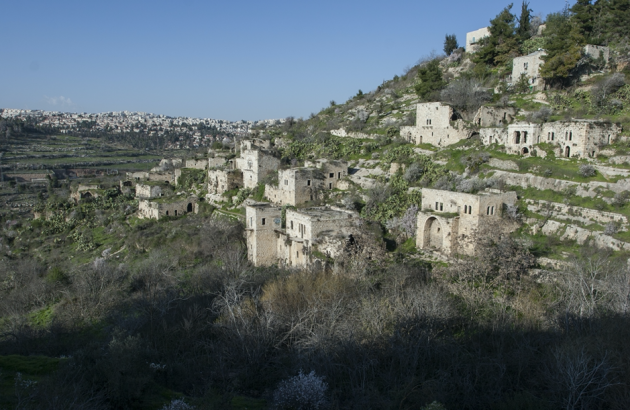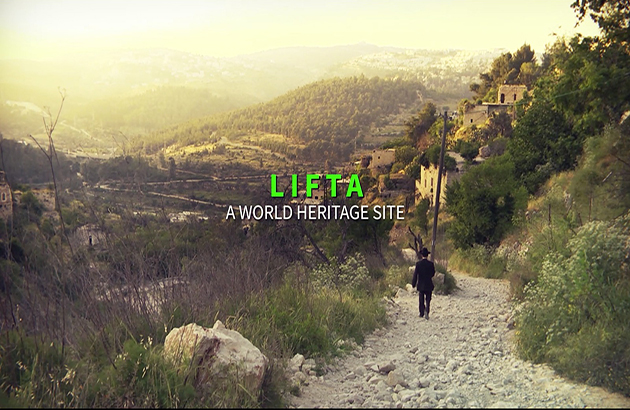Built in the 16th century, at the western entrance to Jerusalem lies Lifta, the well-preserved remains of a Palestinian village. Archeological and architectural remains attest to a continuity of thousands of years of settlement in Lifta.
During the Ottoman period, the village of Lifta was a major agricultural hinterland of Jerusalem and had an array of olive presses and flour mills.
Many Jerusalem neighborhoods, both Jewish and Arab, were built on lands purchased from the village at the end of the 19th century. In 1948, following the formation of the state of Israel, the village inhabitants fled to East Jerusalem and other parts of the West Bank.
In the 1950’s, Jewish families, new immigrants from Yemen and Kurdistan, were resettled in the village. These families were evacuated by the State of Israel in 2017, the last inhabitants of Lifta.
Present | from a unique cultural landscape to an elite-class villa neighbourhood ?
The village of Lifta is the only remnant to survive in such remarkable condition, of an architectural and agricultural society, prevalent in the Middle East for thousands of years.
Lifta was recently added to the Tentative List of World Heritage Sites by the Israeli Committee for UNESCO in the Ministry of Education.
Today, Lifta has a rich habitat for many plants and animals, and a natural water spring. The beauty of Lifta is a hallmark and an inseparable part of the entrance to Jerusalem, the city’s scenery and its charm.
Construction plan ‘6036’ is currently being vigorously promoted by the Jerusalem Municipality and the Israel Land Authority. The plan is intended to destroy the cultural landscape of Lifta and build an elite-class villa neighborhood, with roads, parking structures, and retaining walls.

Future | building an alternative vision for Lifta
The Save Lifta Coalition has been operating since 2010 to stop plan 6036 and promote an alternative plan that will focus on preserving Lifta’s cultural landscape as a local and universal heritage site for future generations. In our vision, Lifta is a tourist and research site, an open-air museum of Arab cultural heritage, where one can learn about the ancient ways of life that developed here in the Middle East. In our vision Lifta is a model for the search for paths to a shared life of peace, reconciliation and justice.
On Tuesday, August 3, 2021, Adv. Dr. Sami Arshid filed a petition in the Jerusalem Administrative Court against the Israel Land Authority, demanding the cancellation of the tender for the planning and construction of 259 villas, commercial buildings and a hotel in the abandoned village of Lifta, and the 6036 construction plan.
Adv. Dr. Arshid, representing associations and individuals working for the preservation of Lifta, including Jerusalem residents of Lifta, asked the court to order the cessation of all marketing or sale of the plots in Kfar Lifta and to oblige the Israel Land Authority to submit a new plan for the preservation of Lifta village. Will implement the findings of a survey by the Antiquities Authority in Lifta, and will address the declaration that Lifta is a candidate for recognition as a World Heritage Site by UNESCO.
In 2017, the Israel Antiquities Authority published a detailed survey finding that the built array of the village of Lifta as well as the array of roads, terraces, historical division of plots, natural finds, agriculture and the environment within the village were not assimilated in Plan 6036.
The survey by the Israel Antiquities Authority clarifies that there are sites in Lifta that deserve to remain in the hands of the public and are fully accessible to the public as part of the hiking trails in the village: clothing houses, wineries, caves, and unique buildings. According to the current tender, these sites are marketed and transferred to the private entrepreneur without any guidance and construction of a mechanism for their actual preservation and making them available to the public. The petitioners claim that “marketing the Lifta site as a whole (447 dunams) to one developer and as a result the construction of new buildings on the village lands and in place of the existing village, therefore thwarts the ability to preserve the existing village and thwart any possibility of preserving the full historical structure of the village.”
The marketing of the lands of the village of Lifta, along with the dispossession of the historical rights of the original residents is also an unreasonable move in light of the fact that the marketing was done without regard to historical property rights that were never detached from the place and without regard to necessary planning and preservation considerations. It will cause weeping for generations, erasing a piece of history and a landscape that is invaluable.”
This petition is also against the Israel Antiquities Authority and the Jerusalem Municipality, who are required to “stabilize the existing buildings in the area of the abandoned village of Lifta in order to prevent the collapse of the buildings or any part of them professionally with architects, engineers and conservation contractors.”
The petition is accompanied by three professional opinions that clarify why Plan 6036 approved in 2006 should be repealed.
Amos Sheeran, a civil engineer, compared in his opinion between the road plan in plan 6036 and the survey by the Israel Antiquities Authority and shows in the plans that some of the roads planned in plan 6036 are too close to existing buildings and in some cases even “through” existing houses. He also warns that the paving works as marked in the plan, may cause the collapse of existing structures as a result of quarrying or vibrating works required for the breakthrough.
Ecologist Dr. David Shahmi writes in his opinion that “The village of Lifta is a cultural landscape site that is unparalleled in the world of the spring, the agricultural terraces and the natural landscape are an integral part of the place’s authenticity that gives it its identity and global importance for conservation. Uniquely the integration of the village in nature and the traditional agricultural use of land and water resources. Years of settlement on the site, thus the main and universal importance of Lifta: the human cultural heritage derives from the cultural landscape in which it grew and developed, nourishes it and nourishes it.This complex, of natural, agricultural and built, make up a world-class cultural heritage site and cultural landscape. At the Lifta complex, there is a rare opportunity to preserve a cultural landscape with its human and natural components, which was typical of the country in the past but has disappeared almost completely under the wheels of development.
The Lifta site has been defined as a declared and well-known urban nature site in Jerusalem, part of the sequence of open areas that surround the city (the Cedar Valley and the Mitzpe Naftah). This sequence feeds Lifta and takes place in connection with it, allows connectivity and the passage of plants and animals and ensures, provided proper preservation , the continued existence of the natural systems at the site and its surroundings. “Plan 6036 for construction in Lifta will introduce construction and infrastructure that will change the flow of runoff water and water infiltration and will adversely affect the moist habitat, and natural habitats will be eradicated for fear of fires and the presence of unwanted animals.”
Plan 6036 does not provide any solution for the preservation of Lifta. A calculated, in-depth and challenging process of redesign aimed at preserving Lifta on all its components must begin.
The third opinion, signed by five well-known architects and conservation planners in Israel, clarifies that the Antiquities Authority’s directive to keep only the original construction volume in the center of the village contradicts the existing plan that allows new construction in the center of the village. Construction rights in the new center of the village set in the program 6036 is not derived from a survey and defined before the report was drawn Antiquities Authority. The existing scheme has not been updated in accordance with the IAA and it contradicts these guidelines. Moves conservation required in practice today are stabilizing and strengthening minimum of existing structures, beyond For this it was appropriate to leave the village in its present condition for future generations.
Save Lifta
Video producer – Sher Knobler
~ Save Lifta

